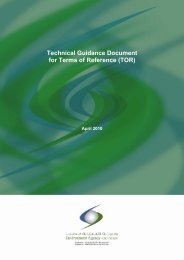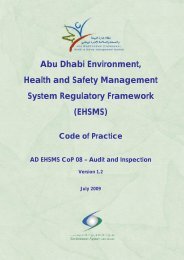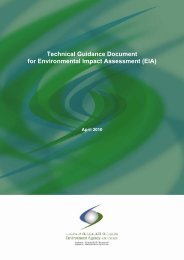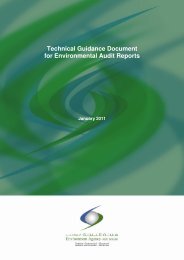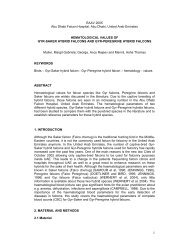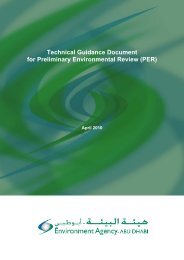Standard Operating Procedure (SOP) for Compliance Monitoring ...
Standard Operating Procedure (SOP) for Compliance Monitoring ...
Standard Operating Procedure (SOP) for Compliance Monitoring ...
You also want an ePaper? Increase the reach of your titles
YUMPU automatically turns print PDFs into web optimized ePapers that Google loves.
Application of the CEMS at Thermal Power Plants<br />
centroid, the more likely the PM concentration at that point will be representative of the average PM<br />
concentration.<br />
Another factor to consider when placing a PM CEMS probe is the location of reference test method<br />
sampling ports. As required by PS-11, PM CEMS are calibrated by developing a correlation between<br />
PM CEMS responses and reference test method measurements (typically, U.S. EPA Method 5). To<br />
develop a good correlation between PM CEMS responses and reference test method measurements,<br />
the PM CEMS location should be as close as possible to the cross-section where sampling ports are or<br />
can be located. In general, locating a PM CEMS near other types of CEMS (e.g., SO 2 or NO x CEMS)<br />
should not present a problem.<br />
1.2.5.3 General Installation Requirements<br />
Installing a PM CEMS on a combustion unit has the same general requirements as installing a CEMS<br />
used to measure a gaseous pollutant (e.g., SO 2 or NO x ). These requirements include installing a<br />
sampling port in the stack <strong>for</strong> the PM CEMS, and, if there are no existing test ports, additional ports<br />
<strong>for</strong> emissions source testing. Depending on the location of the CEMS, it may also be necessary to<br />
install a plat<strong>for</strong>m to allow personnel to easily access the analyser and other system components.<br />
Once a PM CEMS is installed, a series of diagnostic tests is per<strong>for</strong>med to check that all components<br />
are functioning properly. The data acquisition system should also be programmed <strong>for</strong> converting input<br />
signals to the proper units and recording data with the appropriate averaging time and other<br />
requirements specified in the applicable regulation.<br />
1.2.5.4 Shakedown and Preliminary Testing<br />
The proposed version of PS-11 included the requirement <strong>for</strong> operating the PM CEMS <strong>for</strong> both a<br />
shakedown and correlation test planning period prior to conducting the correlation test to certify the<br />
instrument. Although the final rule does not require these preliminary testing periods, they are still<br />
recommended. The purpose of the shakedown period is to allow Operators to work out initial<br />
problems and familiarise themselves with the operation of the instrument and monitoring system.<br />
Based on demonstration studies conducted by U.S. EPA and industry comparing the per<strong>for</strong>mance of<br />
various types of PM CEMS, extractive-type PM CEMS generally are more likely to have problems<br />
during installation and initial start up than are in situ PM CEMS due to the additional mechanical<br />
components needed <strong>for</strong> transporting the sample to the analyser, heating the sample, and measuring<br />
sample volume.<br />
The correlation test planning period allows time <strong>for</strong> the operator to conduct a “dry run” of the<br />
correlation test to help ensure that the correlation test is conducted without problems. Ultimately,<br />
conducting the correlation test over a wide range of PM concentrations is critical to developing a<br />
correlation that will remain representative over the entire range of normal operating conditions; the<br />
correlation test planning period allows time to determine what ranges of PM concentrations are<br />
feasible during the correlation test.<br />
1.2.5.5 Correlation Test<br />
Be<strong>for</strong>e a PM CEMS can be used to monitor emissions, it is necessary to establish the relationship<br />
between PM concentrations in the gas stream and how the instrument responds to those PM<br />
concentrations. A correlation test is used to establish this relationship. The minimum requirements<br />
specified in PS-11 <strong>for</strong> correlation tests include a minimum of 15 test runs, during which the response<br />
of the PM CEMS is recorded with simultaneous reference method measurements of PM<br />
concentrations. The reference method used should be the same method that is specified in the<br />
applicable regulation, typically, U.S. EPA Method 5, 5i, or 17 in 40 CFR Part 60, Appendix A. Paired<br />
reference test method sampling trains (i.e., two independent sampling trains measuring PM<br />
concentrations simultaneously) are recommended to ensure the accuracy of PM concentration<br />
measurements. To ensure that the correlation is valid over the entire range of normal operating<br />
conditions and control device per<strong>for</strong>mance, the correlation test should also be conducted over as wide<br />
A1-14





